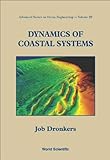Dynamics of coastal systems / Job Dronkers.
Material type: TextSeries: Advanced series on ocean engineeringPublication details: Singapore ; Hackensack, N.J. : World Scientific Pub. Co., ©2005.Description: 1 online resource (xix, 519 pages) : illustrations, mapsContent type:
TextSeries: Advanced series on ocean engineeringPublication details: Singapore ; Hackensack, N.J. : World Scientific Pub. Co., ©2005.Description: 1 online resource (xix, 519 pages) : illustrations, mapsContent type: - text
- computer
- online resource
- 9789812775252
- 9812775250
- 551.45/7 22
- GB451.2
| Item type | Home library | Collection | Call number | Materials specified | Status | Date due | Barcode | |
|---|---|---|---|---|---|---|---|---|
 Electronic-Books
Electronic-Books
|
OPJGU Sonepat- Campus | E-Books EBSCO | Available |
Includes bibliographical references (pages 486-511) and index.
1. Introduction. 1.1. What is this book about? 1.2. Why this book? 1.3. Who is this book intended for? 1.4. How is this book organised? -- 2. Morphodynamic feedback. 2.1. Pattern generation. 2.2. Time-symmetry breaking. 2.3. Spatial symmetry breaking. 2.4. Linear stability analysis. 2.5. Instability of a two-channel system. 2.6. How does the sea shape the land? -- 3. Current-topography interaction. 3.1. Abstract. 3.2. Bed-flow interaction. 3.3. Dunes and ripples. 3.4. Sand banks. 3.5. Channel bars and meanders. 3.6. Will seabed perturbations always grow? -- 4. Tide-topography interaction. 4.1. Abstract. 4.2. Description of tidal inlets. 4.3. Tides. 4.4. Tidal propagation in a few selected basins. 4.5. Equilibrium of river tidal inlets. 4.6. Equilibrium of barrier tidal inlets. 4.7. Transport of fine sediment -- 5. Wave-topography interaction. 5.1. Abstract. 5.2. Morphodynamics of sandy coasts. 5.3. Wave theory. 5.4. Shoreline dynamics. 5.5. Coastal profile dynamics -- 6. Epilogue. 6.1. Progress in understanding. 6.2. Working with nature. 6.3. Future challenges.
Dynamics of Coastal Systems is about the dynamic interaction between water motion and seabed topography, which affects the natural response of coastal systems to change in external conditions and to human interventions -- from the scale of seabed ripples up to the scale of entire barrier and delta systems. The book highlights major concepts developed during the past 50 years for the description of current-topography, tide-topography and wave-topography interactions. It provides simple analytical tools and models for diagnosing and predicting coastal response to change, with references to a great variety of coastal systems around the world. These concepts and tools are crucial for sustainable management of beaches, deltas and coastal wetlands. The book is based on a master course on coastal morphodynamics given at the Universities of Utrecht and Delft in The Netherlands for graduate students who are familiar with the basic concepts of coastal hydrodynamics. It enables coastal engineers to complete their background knowledge and to facilitate access to cutting-edge scientific literature on specific topics. The book may also serve to familiarise consultants, practitioners and academics in related coastal disciplines with modern concepts of land-sea interaction.
eBooks on EBSCOhost EBSCO eBook Subscription Academic Collection - Worldwide
There are no comments on this title.

